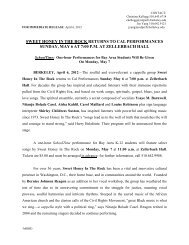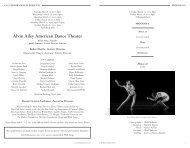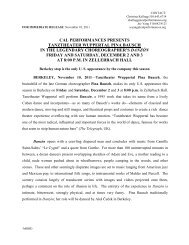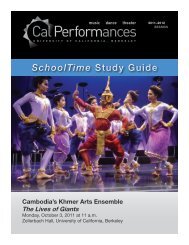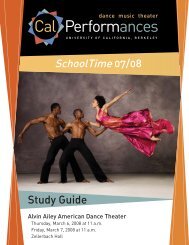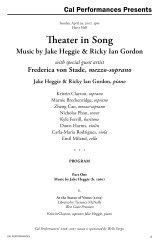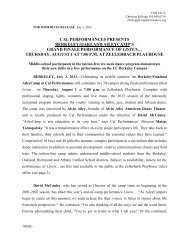SchoolTime Study Guide - Cal Performances - University of ...
SchoolTime Study Guide - Cal Performances - University of ...
SchoolTime Study Guide - Cal Performances - University of ...
- No tags were found...
You also want an ePaper? Increase the reach of your titles
YUMPU automatically turns print PDFs into web optimized ePapers that Google loves.
2010–2011Season<strong>SchoolTime</strong> <strong>Study</strong> <strong>Guide</strong>Alvin Ailey American Dance TheaterThursday, March 31, 2011 at 11 a.m.Friday, April 1, 2011 at 11 a.m.Zellerbach Hall, <strong>University</strong> <strong>of</strong> <strong>Cal</strong>ifornia, Berkeley
Welcome to <strong>SchoolTime</strong>Your class will attend a performance <strong>of</strong> Alvin Ailey American Dance Theater on Thursday,March 31 or Friday, April 1 at 11am (check your confirmation form).An electrifying international presence for over 50 years, the Ailey company is committed topromoting dance as a medium for honoring the past, celebrating the present, and fearlesslyreaching into the future. Its spectacular repertoire ranges from cutting-edge modernchoreography to spirituals, hip-hop, jazz, Afro-Caribbean rhythms, and rhythm and blues.Using This <strong>Study</strong> <strong>Guide</strong>You can use these materials to engage your students and enrich their field trip to ZellerbachHall. Before coming to the performance, we encourage you to:• Copy the Student Resource Sheet on pages 2-3 for your students to use before the show.• Discuss the information on pages 4-9 About the Performance & Artists.• Read About the Art Form on page 10 and About the Music on page 12 with your students.• Engage your class in two or more <strong>of</strong> the activities on pages 15-17.• Reflect by asking students the Guiding Questions, on pages 2, 4, 10 & 12.• Immerse students further into the subject matter by using the Resource and Glossarysections on pages 18-19.At the performance:Your students can actively participate during the performance by:• Observing how the dancers express emotions and ideas through their movements• Listening to how the music and lyrics add to the meaning and emotional quality <strong>of</strong> the dance• Thinking about how music, costumes and lighting contribute to the overalleffect <strong>of</strong> the performance• Marveling at the physical and mental discipline <strong>of</strong> the dancers• Reflecting on the sounds, sights, and performance skills you experience at the theaterWe look forward to seeing you at <strong>SchoolTime</strong>!<strong>SchoolTime</strong> Alvin Ailey American Dance Theater |
Table <strong>of</strong> Contents1. Theater Etiquette 12. Student Resource Sheet 23. About the Performance & Artists 44. About the Art Form 85. About the Music 106. Learning Activities 137. Glossary 178. <strong>Cal</strong>ifornia State Standards 18About <strong>SchoolTime</strong> 19| <strong>SchoolTime</strong> Alvin Ailey American Dance Theater
2Student Resource SheetAlvin Ailey American Dance TheaterAdapted from The Kennedy Center’s CuesheetQuestions to Think About During the Performance• What does the Ailey company <strong>of</strong>fer besides performances?• What influenced Ailey’s choreography?• What was the role <strong>of</strong> spirituals?What You’ll SeeAnointed (excerpt)Choreography: Christopher L. HugginsAnointed is a tribute to the Ailey legacy and thepeople who have helped shape the company, aswell as a celebration <strong>of</strong> the company’s past, and areflection <strong>of</strong> the promise that lies ahead.SoloChoreography: Hans van ManenIn this whirlwind <strong>of</strong> movement and musicality,three men engage in a playful dance rivalry thatshowcases the performers’ daring agility andgrace.RevelationsChoreographer: Alvin AileyRevelations, created in 1960, is based on AlvinAiley’s childhood memories <strong>of</strong> worshipping at hisBaptist church in Texas. The music is a compilation<strong>of</strong> African American spirituals.About Alvin Ailey American DanceTheaterAlvin Ailey created his dance company in1958. His intention was to make new and expressivemodern dance works based on African Americanculture and heritage. To make the company’srepertory (selection <strong>of</strong> works) varied, he includedpieces by new and established choreographers.Over its 50-year history, the company has performedfor almost 20 million people worldwide, and earnedthe reputation <strong>of</strong> one <strong>of</strong> the most popular Americandance companies.The Alvin Ailey American Dance Center wasfounded in 1969, and today over 3,500 studentsfrom every part <strong>of</strong> the world receive training there.AileyCamp was started in 1989. This uniquenational program invites students aged 11-14 toattend a free summer day camp featuring dance,personal development and creative expressionclasses. <strong>Cal</strong> <strong>Performances</strong> hosts the Berkeley/Oakland AileyCamp for six weeks every summer.2 |
Alvin AileyAfter Ailey’s death in 1989, Judith Jamison,one <strong>of</strong> Ailey’s leading dancers, became thecompany’s director. Today, Jamison continuesAiley’s commitment to bringing dance to allpeople.About Modern Dance and Ailey’sChoreographyModern dance developed in Americanearly 100 years ago as a reaction against therules and structure <strong>of</strong> ballet. In ballet, dancersappear weightless and perform elegant steps thatwere created hundreds <strong>of</strong> years ago. Moderndancers embrace gravity and create choreographyfrom everyday movements like walking, skipping,running, and falling.Ailey carefully observed ordinary peopleas they moved, then chose movements that hadthe most meaning for him and put them togetherin a dance. His unique choreographic style wasinfluenced by three modern choreographers—Lester Horton, Katherine Dunham and MarthaGraham.• Lester Horton’s dancers used as muchspace as possible while turning, bending, andjumping across large distances.• Katherine Dunham incorporatedCaribbean, African and American cultural dancestyles to create unique movements.• Martha Graham’s dance technique wasbuilt on contraction (becoming smaller and morepressed together) and release—movements thatimitate the act <strong>of</strong> breathing. In a contraction, thedancer exhales and curves the spine; in a release,the dancer inhales and lifts the chest.About SpiritualsThe songs used in Revelations are calledspirituals. These are folk songs describingpersonal religious experiences. When Africanswere brought to America as slaves, they lost theirtraditional music as well as their freedom. Theyadded African chants, rhythms and harmoniesto the Christian songs they learned and createdspirituals. Today, people sing spirituals to raisetheir spirits, strengthen their faith, and createa sense <strong>of</strong> community. There are two kinds <strong>of</strong>spirituals:• Sorrow songs are sung slowly and sadlyand tell <strong>of</strong> the heavy burden <strong>of</strong> slavery and thebelief that better days are coming.• Jubilees are faster, upbeat songs based onBible stories celebrating victory and joy.Spirituals came to serve many purposes forthe slaves:• Work—Singing spirituals made work lessboring and set a rhythm for actions like picking ordigging. Slave owners liked the singing because itmade the slaves more productive.• Worship—At night, after the owners wereasleep, the slaves would go out into the woods(their invisible church) and worship. Spiritualswere a big part <strong>of</strong> their religious ceremony.• Entertainment—At the end <strong>of</strong> a long day,slaves would <strong>of</strong>ten sing spirituals for relaxation.• Code Songs—Communication throughspirituals, <strong>of</strong>ten helped slaves escape. Forexample, a hidden message in the song “DeepRiver” led to a meeting at the river. “Wade in theWater” warned an escaped slave to go into theriver so bloodhounds couldn’t follow his scent.<strong>SchoolTime</strong> Alvin Ailey American Dance Theater | 3
3Guiding Questions:♦♦♦♦♦♦About the Performance & ArtistsWhat are some <strong>of</strong> dancer/choreographer Alvin Ailey’s achievements?What factors inspired Alvin Ailey to create Revelations?Alvin Ailey American Dance TheaterCircus OzName some <strong>of</strong> the Ailey company’ s programs for young people.4 |The <strong>SchoolTime</strong> PerformanceAnointed (Excerpt)Choreography: Christopher L. HugginsMusic: Moby and Sean ClementsCostume Design: Christopher L. HugginsLighting: Al CrawfordThis tribute to the Ailey legacy, includes threesection. The duet “Passing,” portrays Alvin Aileyhanding leadership <strong>of</strong> the company to JudithJamison. “Sally Forth” celebrates Ms. Jamisonand the many women <strong>of</strong> the company. “52 andCounting” celebrates the number <strong>of</strong> years thecompany has been in existence.SoloChoreography: Hans van ManenMusic: Johann Sebastian BachCostumes: Keso DekkerLighting: Joop CaboortIn this whirlwind <strong>of</strong> movement and musicality,three men engage in a playful dance rivalryshowcasing their agility and grace.RevelationsChoreography by Alvin Ailey, 1960Music: African American SpiritualsDecor and Costumes by Ves HarperCostume redesign by Barbara ForbesLighting by Nicola Cernovitch
The Inspiration for RevelationsRevelations began with the music. As early as Ican remember I was enthralled by the music playedand sung in the small black churches in every smallTexas town my mother and I lived in. No matter wherewe were during those nomadic years, Sunday wasalways a church-going day.With pr<strong>of</strong>ound feeling, with faith, hope, joyand sometimes sadness, the choirs, congregations,deacons, preachers, and ushers would sing blackspirituals and gospel songs. They sang and playedthe music with such fervor that even as a small child Icould not only hear it but almost see it. I tried to putall <strong>of</strong> that feeling into Revelations.Creating the DanceAbout Revelations (excerpts from the autobiography <strong>of</strong> Alvin Ailey)The opening part <strong>of</strong> Revelations was about tryingto get up out <strong>of</strong> the ground. The costumes and setwould be colored brown and earth color, for comingout <strong>of</strong> the earth, for going into the earth. The secondpart was something that was very close to me—thebaptismal, the purification rite. Its colors would bewhite and pale blue. Then there would be the sectionsurrounding the gospel church, the holy rollers, andall that church happiness. Its colors would be earthtones, yellow, and black.The first version <strong>of</strong> Revelations was quite long, anhour and five minutes, and it had three sections. Thefirst was called “Pilgrim <strong>of</strong> Sorrow.” I took all the songsdealing with black people’s sorrow and put them inthis section. The middle section was to be wading inthe water. Songs such as “Honor, Honor” had all theextraordinary words. I was moved by what spiritualssay as words, as metaphors. So I found these shortsongs for the middle section.There were quite a few songs for the last section,“Move, Members, Move.” The whole ballet was agigantic suite <strong>of</strong> spirituals. I poured in just abouteverything, every beautiful spiritual I had ever heard.<strong>SchoolTime</strong> Alvin Ailey American Dance Theater | 5
Alvin Ailey American Dance TheaterFor over 50 years, Alvin Ailey AmericanDance Theater has brought African Americancultural expression and the American moderndance tradition to the world’s stages.Mr. Ailey founded his company in 1958.Over the next 10 years, he created approximately20 ballets, among them Revelations (1960).He ensured that the company’s repertory alsoincluded works by dance pioneers and emergingchoreographers. Over the past 50 years, thecompany has produced more than 180 works by77 choreographers. Performing for an estimated19 million people in 48 states, 68 countries and onsix continents, Alvin Ailey American Dance Theaterhas earned a reputation as one <strong>of</strong> the most popularinternational ambassadors <strong>of</strong> American culture.The Alvin Ailey American Dance Center wasfounded in 1969 with an initial enrollment <strong>of</strong> 125students. Today, over 3,500 dance students fromevery part <strong>of</strong> the world receive training there.This diverse group <strong>of</strong> students contributes to amulticultural richness that is unique among danceschools.In 1974, Ailey formed the Repertory Ensemble,now called Ailey II as a way for talented students tomake the leap from studio to stage.The company has a long-standing involvementin arts education, including a unique nationalprogram called AileyCamp. AileyCamp bringsunderserved youngsters to a full-scholarshipsummer day camp that combines dance classes withpersonal development, creative writing classes andfield trips. The Berkeley/Oakland AileyCamp at <strong>Cal</strong><strong>Performances</strong> is now in its tenth year.6 |
Alvin Ailey (1931-1989)Born in Rogers, Texas, on January 5, 1931, AlvinAiley spent his formative years going to SundaySchool and participating in the Baptist Young PeoplesUnion – experiences that later inspired Revelations.Mr. Ailey began his formal dance training inLos Angeles motivated by performances <strong>of</strong> theKatherine Dunham Dance Company and classeswith Lester Horton. Horton, the founder <strong>of</strong> thefirst racially integrated dance company in theUnited States, was a catalyst for Ailey’s career.After Horton’s death in 1953, Ailey became thedirector <strong>of</strong> the Horton Dance Theater and began tochoreograph his own works. Soon after, he foundedthe Alvin Ailey American Dance Theater.Alvin Ailey died on December 1, 1989, andwith his death American dance lost one <strong>of</strong> its mostluminous stars. Anna Kisselg<strong>of</strong>f <strong>of</strong> The New YorkTimes wrote “You didn’t need to have known Alvinpersonally to have been touched by his humanity,enthusiasm and exuberance and his courageousstand for multiracial brotherhood.”Judith Jamison, Artistic DirectorA native <strong>of</strong> Philadelphia , Judith Jamison becamea member <strong>of</strong> Alvin Ailey American Dance Theater in1965 and danced with the company for 15 years togreat acclaim. She was appointed Artistic Director<strong>of</strong> Alvin Ailey American Dance Theater in December1989 at the request <strong>of</strong> her mentor, Alvin Ailey. Whennamed Artistic Director <strong>of</strong> the Company, she said“I view this appointment as the course to take tocontinue my vision and keep Mr. Ailey’s vision alive.”For 22 years, Judith Jamison has presided overan artistically and fiscally vibrant Ailey organization.Following Mr. Ailey’s ideals, Ms. Jamison has beendedicated to asserting the prominence <strong>of</strong> the arts inour culture, spearheading initiatives to bring danceinto the community and programs that introducechildren to the arts. She remains committed topromoting the Ailey legacy—dance as a mediumfor honoring the past, celebrating the present andfearlessly reaching into the future.Robert Battle, Artistic DirectorDesignateIn July 2011, Robert Battle will succeed JudithJamison as Artistic Director <strong>of</strong> Alvin Ailey AmericanDance Theater, becoming only the third person tohead the Company since its founding by Mr. Ailey in1958. In announcing her selection, Ms. Jamison saidthat “choosing Robert Battle is the giant leap I want totake to ensure that this company stays vibrant in thefuture.” Mr. Battle has already had a long associationwith the Ailey organization, as a choreographer andan artist-in-residence.Raised in Miami, Florida, he first began studyingmodern dance in high school, continuing on to graduatefrom The Juilliard School with a degree in Dance. Mr.Battle danced with the Parsons Dance Company from1994 to 2001, and began setting his own choreographyin 1998. Shortly thereafter he founded his ownBattleworks Dance Company. He has created newworks and restaged ballets for diverse and prestigiouscompanies, and regularly conducts residencies and givesmaster classes around the globe.<strong>SchoolTime</strong> Alvin Ailey American Dance Theater | 7
Dance TechniquesHortonCreated by Lester Horton, this is a techniquethat explores how many different ways the bodycan move. Horton named these movements“studies.” Some studies are for balance, somefor strengthening and some for working on theswinging action <strong>of</strong> the body. A Horton danceruses as much space as possible: turning, bendingand jumping sideways, backwards and evenupside-down. The shapes created are clear andlinear. The Horton technique gives a feeling <strong>of</strong>strength and energy.DunhamMartha GrahamCreated by Katherine Dunham, this techniqueblends Caribbean, West African and AfricanAmerican folk patterns <strong>of</strong> movement and rhythms.The original dance patterns have been preserved,but the dances have been slightly modified inkeeping with modern dance form. The techniquealso employs the styles <strong>of</strong> ballet, modern dance,jazz and basic folk patterns.GrahamMartha Graham created a technique basedon the principle <strong>of</strong> contraction and release,movement that is similar to the act <strong>of</strong> breathing,which creates a current <strong>of</strong> energy through thebody. The back appears rounded in a contractionand the chest is lifted in a release. Movementitself is dramatic and expressive.Katherine Dunham<strong>SchoolTime</strong> Alvin Ailey American Dance Theater | 9
3. ENTERTAINMENT. At the end <strong>of</strong> a long day, orduring time <strong>of</strong>f on a Sunday, slaves would <strong>of</strong>tensing spirituals for relaxation.4. CODE SONGS. An important function <strong>of</strong>spirituals was their use in helping slaves escape.Code songs are songs that have hidden messages.The spiritual, “Deep River,” for example, was sungto announce a meeting at the river:Deep riverMy home is over Jordan, yesDeep river, Lord,I want to cross over into camp groundWhen the master had discovered theabsence <strong>of</strong> a runaway slave, the other slaves on theplantation might sing “Wade in the Water.” Slaveson neighboring plantations would hear the songand take it up, and the runaway, wherever he was,would know that he should take to the river so thebloodhounds would not be able to follow his scent.Performance <strong>of</strong> SpiritualsThere are two kinds <strong>of</strong> spirituals:• Sorrow songs are sung slowly andmournfully, and told <strong>of</strong> the heavy burden <strong>of</strong>slavery and the belief that a better day wascoming.• Jubilees are up-tempo songs celebratingvictory and joy through reference to biblicalfigures like Samson or David who overcametremendous hardships.The Music <strong>of</strong> RevelationsRevelations is a dance in threesections, each choreographed to aselection <strong>of</strong> spirituals. The followingpages include the lyrics to a sampling <strong>of</strong>the music from Revelations.1. Pilgrim <strong>of</strong> Sorrow“I Been ‘Buked”“Didn’t My Lord Deliver Daniel”“Fix Me, Jesus”2. Take Me to the Water“Wade in the Water”“A Man Went Down to the River”“I Want to Be Ready”3. Move Members Move“Sinner Man”“The Day Is Past and Gone”“You May Run On”“Rocka-My-Soul”<strong>SchoolTime</strong> Alvin Ailey American Dance Theater | 11
Section 1:Pilgrim <strong>of</strong> SorrowI’ve Been ‘BukedI’ve been ‘buked an’ I’ve been scorned, Yes,I’ve been ‘buked an’ I’ve been scorned, ChildrenI’ve been ‘buked an’ I’ve been scorned,I’ve been talked about sho’s you’ born.Dere is trouble all over dis worl’, Yes,Dere is trouble all over dis worl’, Children.Dere is trouble all over dis worl’Dere is trouble all over dis worl’Ain’ gwine lay my ‘ligion down, No,Ain’ gwine lay my ‘ligion down, Children.Ain’ gwine lay my ‘ligion down,Ain’ gwine lay my ‘ligion down.I’ve been ‘buked I’ve been scorned, YesI’ve been ‘buked I’ve been scorned, Children.I’ve been ‘buked I’ve been scorned.I’ve been talked about sho’s you’ born.Fix Me JesusOh, fix me, Oh, fix me, Oh, fix me.Hm——— Hm———-Fix me, Jesus, fix me.Hm——— Oh, fix me, Oh, fix me,Oh, fix me. Fix me, Jesus, fix me.Fix me for my long, white robe.Hm——— Fix me, Jesus, fix me.Fix me for my starry crown.Hm——— Fix me, Jesus, fix me.Oh, fix me, Oh, fix me, Oh fix me.Fix me, Jesus, fix me.Hm——— Fix me, Jesus, fix me.Fix me for my dyin’ bed.Hm——— Fix me Jesus, fix me.Hm——— Fix me Jesus, fix me.Fix me for my journey home.Hm——— Fix me Jesus, fix me.Oh, fix me, Oh, fix me, Oh, fix me, Lord.Oh, fix me, Oh,Fix me, Jesus, fix me. Hm———Fix me, oh, fix me. Fix me, Jesus, fix me.Section 2:Take Me to the WaterWade in the WaterWade in the water (4x).Wade in the water, children,God’s a gonna trouble the water.God’s a gonna trouble that band all dressedin white.God’s gonna trouble the water.It look like the band <strong>of</strong> the Israelite.God’s gonna trouble the waterWade in the water.Wade in the water children.Wade in the water.God’s a gonna trouble the water.See that band all dressed in red.God’s gonna trouble the water.Look like the band that Moses led.God’s gonna trouble the water.Wade in the water.Wade in the water children.Wade in the water.God’s a gonna trouble the water.Didn’t my Lord deliver Danuwell (Daniel)Danuwell Danuwell?Didn’t my Lord deliver Danuwell and a whynot a every man.Man went down to the river (2x)Lord, man went down to the river.He went down there to pray.Wash his sins away.He wash all day. He wash all night.He wash ‘til his hand were sore. He washall day.He wash all night ‘til he couldn’t wash emno more.Man went down to the river. He went downthere to pray.Wash his sins away.Wade in the water. Wade in the water,Children wade in the water.God’s a gonna trouble the water (x3)I Wanna Be ReadyI wanna be ready, I wanna be ready, I wannabe ready,Lord, ready to put on my long white robe.Lord, I wanna be ready, I wanna be ready, Iwanna be ready,Lord, ready to put on my long white robe.I would not be a sinner, I’ll tell you thereason why,‘Cause if my Lord should call on me,Lord, I wouldn’t be ready to die.I wanna be ready, I wanna be ready, I wannabe ready.Lord, ready to put on my long white robe.Lord, I wanna be ready, I wanna be ready, Iwanna be ready.Lord, ready to put on my long white robe.I would not be a gambler, I’ll tell you thereason why.‘Cause if my Lord should call on me,Lord, I wouldn’t be ready to die.I wanna be ready, I wanna be ready, Lord, Iwanna be ready,Lord, ready to put on my long white robe,Be ready to put on my long white robe,Jus’ ready to put on my long white robe.Section 3:Move, Members, MoveThe Day Is Past and GoneThe day is past and gone.The evening shades appear.Oh may we all remember well that the night<strong>of</strong> death draws nigh.You May Run OnYou may run on for a long time. Run on fora long time.You may run on for a long time.Let me tell you a God a mighty gonna cutyou down.Go tell that long-tongued liar, go tell thatmidnight rider.Tell the gambler, rambler back-biter.Tell him God a might gonna cut him down.My head got wet with the midnight dew.The mornin’ star was a witness too,I never shall forget that day when Jesuswashed my sins away.One day, one day, I was walkin’ along hearda voice and saw no one.Voice I heard it sound so sweet made hislove run down to my feet.Go tell that long-tongued liar, go tell thatmidnight rider.Tell the gambler, rambler back-biter.Tell him God a might gonna cut him down.You read about Samson from his birth,Strongest man whoever lived on earth.He lived way back in ancient time.Died and went to heaven in due time.Delilah fooled Samson. Don’t you know theHoly Bible tells you so.She came to Samson on her knees said,Tell me where your strength lies if youplease.Delilah she looked so fair,Samson said, my strength lies in my hair.She shaved his head just as clean as yourhand,Samson got weak as any other man.Go tell that long tongued liar, go tell thatmidnight rider.Tell the rambler, gambler back biter.Tell him God a mighty gonna cut him down.A for Adam man was named placed in thegarden by God’s command.God saw Adam in a lonely state.Put him to sleep and made him a mate.Now Adam bein’ the father <strong>of</strong> the humanrace,Broke God’s law and tried to hide his face.In the cool <strong>of</strong> the evenin’ my Lord camedown,Looked at Adam and began to frown.Adam! Adam! Where are you now?You must earn your bread by the sweat <strong>of</strong>your brow.Go tell that long tongued liar. Go tell thatmidnight rider.Tell the rambler, gambler back biterTell him God a mighty gonna cut him down.Some people go to church for to signify,Tryin’ to make a date with the neighbor’swife,But neighbor, let me tell you,Just as sure as you’re born you better leavethat woman,Better leave her alone, ‘cause one <strong>of</strong> thesedays,Better mark my words, you’ll think yourneighbor has gone to work,You walk right up and knock on the door,That’s all brother you’ll knock no more.Go tell, tell that long tongued liar. Go tellthat midnight riderTell the gambler, rambler back biter.Tell him God a mighty gonna cut him down.12 |
6Learning ActivitiesDance (Grades 3- 12)Everyday Movement1) Ask students to brainstorm a list <strong>of</strong> every day activities, for example; stretching when they wakeup, walking the dog, skipping rope or jumping and throwing a basketball.2) In groups <strong>of</strong> six, have students share their activity, show its movement, then have the otherstudents repeat this movement.3) After students have shared their movements, set the movements by having students go overthem again, this time making sure each movement lasts for eight counts.4) Then, ask students to create an order in which to perform all six, eight-count movements.5) Next, ask students to think <strong>of</strong> the quality they would like for each movement. For example, dothey want to do the movement slowly and fluidly or quickly and jerkily?6) Finally, how much space should the movement take up—is the body stretched out with the legstaking large steps, or crunched into a little ball and hardly moving?7) After repeating the movements several times, ask students to share their pieces.Literacy & Visual Art (Grades 3-8)Poems inspired by spiritualsRemembering the spirituals he heard as a child, Alvin Ailey was inspired to create Revelations. Spirituals are stillpowerful today not only because <strong>of</strong> their historical and cultural significance, but because their messages arefilled with strong human desires and emotions.1) Student Response:• Play a recording <strong>of</strong> a spiritual for the class.• Ask students to listen to the music once, just to hear it.• Play the piece again, and ask students to write words describing the emotions the songmakes them feel or think about.• Ask students to share with a partner some <strong>of</strong> the words• Repeat the song, and ask students to draw a picture inspired by the music.• After posting the drawings, have students do a “gallery walk” around the room.• Hand out small post-it notes to students and ask them to do another “gallery walk.”This time, ask students to suggest titles for drawings, which they can write on the post-itnote and place near the drawing. (Set ground rules about acceptable and non-acceptabletitles).• After students read the suggested titles, play the song again and ask them to writedown words connected with the history and culture <strong>of</strong> spirituals that come to mindwhen they listen to the music.<strong>SchoolTime</strong> Alvin Ailey American Dance Theater | 13
2) Creating a poem inspired by the spiritual• Ask students to choose up to five words from the ones they’ve written or received astitle suggestions.• Ask students to create a short poem or haiku using these words.• Share some <strong>of</strong> the poems.• Extension: In groups, have students choose a poem and create gestures, poses andeventually large movements to express words or phrases in the poem.Dance (Grades K-12)Reflection on RevelationsImmediately after seeing the performance <strong>of</strong> Revelations, ask students to remember movements and gestures.With the students arranged in a circle, ask each one to copy a movement they saw in the performance.Students can work in pairs, showing a movement from a duet. After seeing all the movements, ask students toshare what they think some <strong>of</strong> these movements or gestures represent in terms <strong>of</strong> ideas or emotions. (Use thesection Movements to Watch for in Revelations on page 15 to help with this discussion.)Class Discussion1) What do you think the dance Revelations is about? How did movement, costume, music and lightingconvey the meaning <strong>of</strong> the dance?2) Dance is the language <strong>of</strong> the body. Discuss this statement. Would you consider dance auniversal language? Can you give examples <strong>of</strong> how you understand other people’s intentionsand messages through their movements? How can you tell if someone is really nervous, happyor angry? Have you seen anyone who seems frightening just from their body language?What kinds <strong>of</strong> movements are welcoming gestures?14 |
Movements to Watch for In RevelationsRevelations is a suite <strong>of</strong> dances that tells the story <strong>of</strong> a community <strong>of</strong> people through vignettescomposed <strong>of</strong> large and small groups, trios, duets and solos. Concepts such as oppression, dignity, hopeand determination, and emotions like sorrow, anger, fear and joy, are embodied and expressed throughhuman movement.Below is a list <strong>of</strong> specific dance gestures from Revelations. See if you can recognize some <strong>of</strong> thefollowing moments as you watch the performance and identify the emotions or themes. As everyonehas a unique frame <strong>of</strong> reference, a particular moment may say something different to you than to otherpeople. The dance is rich with imagery—the list here contains only a few <strong>of</strong> them. Have your studentsmake note <strong>of</strong> which scenes particularly stand out to them in order to spark a class discussion followingthe performance.1. THE “BIRD” POSE. How many times did you see it performed as a group in “I Been ’Buked?”In various sections <strong>of</strong> Revelations, a similar movement is done. Look for the “bird” pose repeatedthroughout the dance.2. PRAYING MOVEMENTS: Notice the number <strong>of</strong> different ways praying takes place inRevelations. Think about how it is portrayed and why and where it is done. Students can alsoshare through movement or drawing.3. FALLING TO THE FLOOR IN GRIEF AND DESPAIR happens in three different segments <strong>of</strong> thedance. When do they happen and what do you think they represent?4. RISING INTO THE AIR IN HOPE: In “Fix Me,” one woman is so overcome with despair shefaints twice, but in the end she ascends toward the sky as if on wings.5. LOOKING FOR A PLACE TO HIDE: In the section “Sinner Man,” some <strong>of</strong> the dancers try to hide.Who do you think they represent? What feelings did you experience while watching the dance?6. A MAN AND A WOMAN CLEAR AWAY EVIL SPIRITS: Why do you think they are doing this?What props do the dancers use to accomplish their task?7. THREE PEOPLE WALK INTO A RIVER: How do you know they are in water?8. A MAN CRAWLS ON THE FLOOR IN DETERMINATION: What do you notice about the way hemoves? What else do his gestures convey?9. SEVERAL WOMEN CARRY ON STOOLS: Where are they? What are the doing? Whatemotions are they showing at this time?10. THE WOMEN PLAYFULLY CHASTISE THE MEN: What gestures do they use to do this?11. MEN CARRY THE STOOLS: Why might they do this?12. THE COMPANY IS SWEPT AWAY IN JOY: Describe how the dancers portray this emotion.<strong>SchoolTime</strong> Alvin Ailey American Dance Theater | 15
ResourcesAlvin Ailey American Dance Theaterhttp://www.alvinailey.org/Books:Ailey, Alvin and A. Peter Bailey. Revelations: The Autobiography <strong>of</strong> Alvin Ailey. Secaucus, NJ:Birch Lane Press, 1995.Dunning, Jennifer. Alvin Ailey: A Life in Dance. New York, NY: DeCapo Press, 1998.Pinkney, Andrea Davis. Alvin Ailey. New York, NY: Hyperion Books for Children, 1993.DVD / Video:Four by Ailey VHS. Director Thomas Grimm. Dance Horizons, 1986.Beyond the Steps: Alvin Ailey American Dance Theater DVD. Director Phil Bertelsen. DancePhilm, 2006. Order at: http://www.aileyboutique.com/dvd/http://youtube.com/watch?v=gWJzSP7irwMhttp://youtube.com/watch?v=WefribGizyg&feature=relatedVideo selections from the Ailey repertory:http://www.alvinailey.org/page.php?p=arti&v=611CD / Tape:Alvin Ailey American Dance Theater. Revelations. V2 Records 63881-27036-2, 1998.Order at: http://www.aileyboutique.com/dvd/Podcasts:NPR: Alvin Ailey’s Dance Troupe at 45http://www.npr.org/templates/story/story.php?storyId=191203716 |
7 GlossaryBallet: A dance form started in the royal courts <strong>of</strong>Europe. The body is held mostly upright and thelegs are turned out from the hip. Ballet uses fivebasic positions <strong>of</strong> the feet. Ballet terms are alwaysspoken in French.Arabesque: A ballet position where a dancerbalances on one leg, raises and extends the otherleg behind them, and stretches their arms forward.Artistic director: A person who has artistic control<strong>of</strong> a company’s work. They will <strong>of</strong>ten choose acompany’s season and direct several works.<strong>Cal</strong>l and Response: A style <strong>of</strong> singing in whichthe melody sung by one singer is responded to orechoed.Choreographer: A person who composes danceworks.Duet: Any performance by two people.Dynamics: Variation and gradation in the intensity<strong>of</strong> a movement or musical sound.Ensemble: The united performance <strong>of</strong> an entiregroup.Folk Dance: A style <strong>of</strong> dance that originates amongthe common people <strong>of</strong> a particular nation or region.Movement Vocabulary: Dance movements thatcommonly appear in a choreographer’s works.Repertoire/Repertory: The list <strong>of</strong> works that acompany is prepared to perform.Repertory Company: A dance company thatperforms many types <strong>of</strong> works by many differentchoreographers.Salsa: A lively, vigorous type <strong>of</strong> contemporary LatinAmerican popular music that blends predominantlyCuban rhythms with elements <strong>of</strong> jazz, rock, andsoul music.Solo: Any performance by one person.Spirituals: Religious songs created by AfricanAmerican slaves, the lyrics are <strong>of</strong>ten based onstories from the Bible.Symmetry: An exact matching <strong>of</strong> form andarrangement <strong>of</strong> parts on opposite sides <strong>of</strong> a centralpoint or axis.Tribute: A gift, payment, declaration, or otheracknowledgment <strong>of</strong> gratitude, respect, oradmiration.Trio: A group <strong>of</strong> three.Vignette: A short scene or moment, as from a play.Work: A word that dancers use to refer to a dance;other words that are used in this manner are“piece” and “ballet.”<strong>SchoolTime</strong> Alvin Ailey American Dance Theater | 17
8<strong>Cal</strong>ifornia State StandardsMusic Grades K-121.0 Artistic PerceptionProcessing, Analyzing, and Responding to SensoryInformation Through the Language and Skills Uniqueto MusicStudents read, notate, listen to, analyze, and describemusic and other aural information, using theterminology <strong>of</strong> music.2.0 Creative ExpressionCreating, Performing, and Participating in MusicStudents apply vocal and instrumental musical skillsin performing a varied repertoire <strong>of</strong> music. Theycompose and arrange music and improvise melodies,variations, and accompaniments, using digital/electronic technology when appropriate.3.0 Historical and Cultural ContextUnderstanding the Historical Contributions andCultural Dimensions <strong>of</strong> MusicStudents analyze the role <strong>of</strong> music in past andpresent cultures throughout the world, notingcultural diversity as it relates to music, musicians, andcomposers.Role <strong>of</strong> Music3.1 Describe the social functions <strong>of</strong> a variety <strong>of</strong>musical forms from various cultures and time periods(e.g., folk songs, dances).4.0 Aesthetic ValuingResponding to, Analyzing and Making Judgmentsabout Works <strong>of</strong> MusicStudents critically asses and derive meaning fromworks <strong>of</strong> music and the performance <strong>of</strong> music, theelements <strong>of</strong> music, and original works according to theelements <strong>of</strong> music.Dance Grades K-121.0 Artistic PerceptionProcessing, analyzing, and responding to sensoryinformation through the language and skills unique todanceStudents perceive and respond, using the elements<strong>of</strong> dance. They demonstrate movement skills, processsensory information, and describe movement, usingthe vocabulary <strong>of</strong> dance.2.0 Creative ExpressionCreating, performing and participating in danceStudents apply choreographic principles, processes,and skills to create and communicate meaning throughthe improvisation, composition, and performance <strong>of</strong>dance.3.0 Historical and Cultural ContextUnderstanding the historical contributions andcultural dimensions <strong>of</strong> danceStudents analyze the function and development <strong>of</strong>dance in past and present cultures throughout theworld, noting human diversity as it relates to dance anddancers.4.0 Aesthetic ValuingResponding to, analyzing, and making judgmentsabout works <strong>of</strong> danceStudents critically assess and derive meaning fromworks <strong>of</strong> dance, performance <strong>of</strong> dancers, and originalworks according to the elements <strong>of</strong> dance and aestheticqualities.5.0 Connections, Relationships, ApplicationsConnecting and applying what is learned in dance tolearning in other art forms and subject areas and tocareersStudents apply what they learn in dance to learningacross subject areas. They develop competencies andcreative skills in problem solving, communication, andmanagement <strong>of</strong> time and resources that contribute tolifelong learning and career skills. They also learn aboutcareers in and related to dance.18 |
<strong>Cal</strong> <strong>Performances</strong> thanks the followingdonors for their gifts in support <strong>of</strong> ourEducation and Community Programs:AnonymousBank <strong>of</strong> AmericaJesse and Laren BrillGeorgia E. Cassel, in honor <strong>of</strong> David McCauleyEarl and June CheitRobert Cooter and Blair DeanSuzanne and Elliott FelsonElliot and Shelley FinemanThe Roy and Cindy Ford FamilyThe Robert J. and Helen H. Glaser FamilyFoundationJane Gottesman and Ge<strong>of</strong>frey BiddleEvelyn & Walter Haas, Jr. FundKathleen G. HenschelBeth HurwichSally Landis and Michael WhiteSusan Marin<strong>of</strong>f and Thomas SchragMeyer SoundMaris and Ivan MeyersonPr<strong>of</strong>essor Anthony NewcombEddie and Amy OrtonKenneth and Frances ReidTobey, Julie and Lucy RolandGail and Daniel RubinfeldThe San Francisco FoundationLinda and Will SchieberStephen Schoen and Margot FraserWilliam A. Settles Fund for AileyCampMarkus and Barbara TriceWells Fargo FoundationZellerbach Family FoundationLead Community Partner:About <strong>Cal</strong> <strong>Performances</strong> and<strong>SchoolTime</strong>The mission <strong>of</strong> <strong>Cal</strong> <strong>Performances</strong> is toinspire, nurture and sustain a lifelong appreciationfor the performing arts. <strong>Cal</strong> <strong>Performances</strong>,the performing arts presenter <strong>of</strong> the <strong>University</strong><strong>of</strong> <strong>Cal</strong>ifornia, Berkeley, fulfills this mission bypresenting, producing and commissioningoutstanding artists, both renowned andemerging, to serve the <strong>University</strong> and the broaderpublic through performances and educationand community programs. <strong>Cal</strong> <strong>Performances</strong>celebrates over 100 years on the UC BerkeleyCampus.Our <strong>SchoolTime</strong> program cultivates anearly appreciation for and understanding <strong>of</strong>the performing arts amongst our youngestaudiences, with hour-long, daytime performancesby the same world-class artists who performas part <strong>of</strong> the main season. <strong>SchoolTime</strong> hasbecome an integral part <strong>of</strong> the academic year forteachers and students throughout the Bay Area.<strong>SchoolTime</strong> Alvin Ailey American Dance Theater | 19
This <strong>Cal</strong> <strong>Performances</strong> <strong>SchoolTime</strong> <strong>Study</strong> <strong>Guide</strong> was written,edited and designed by Laura Abrams, Rica Anderson,Nicole Anthony and Sandra GrahamCopyright © 2011 <strong>Cal</strong> <strong>Performances</strong>



